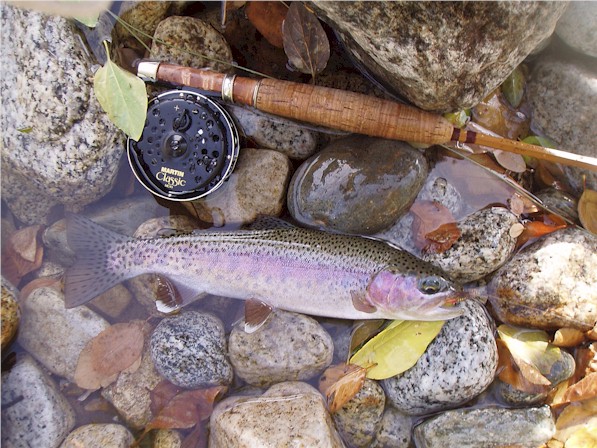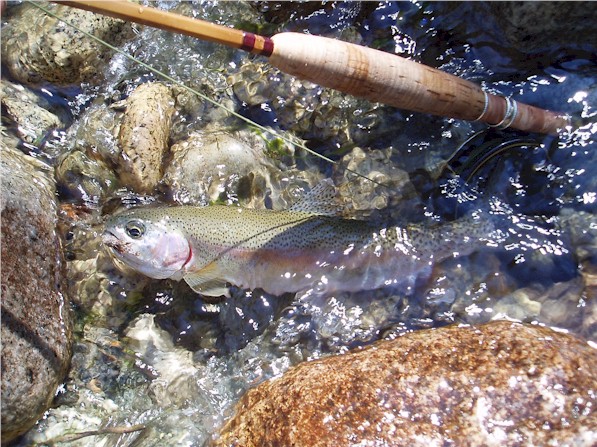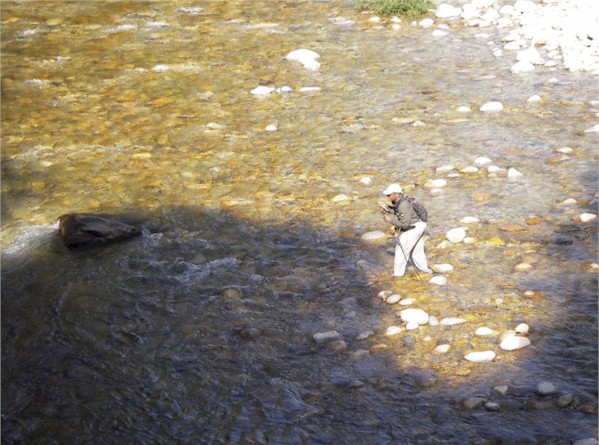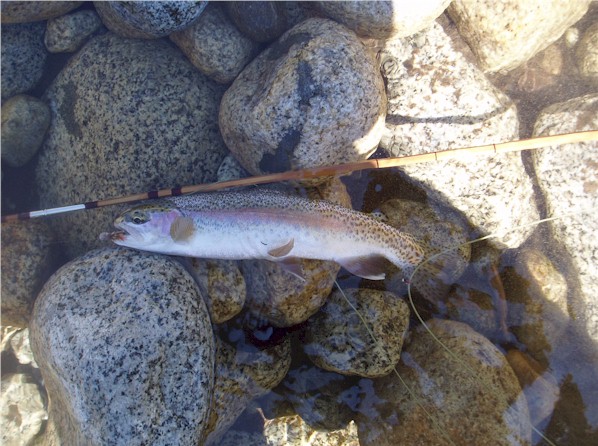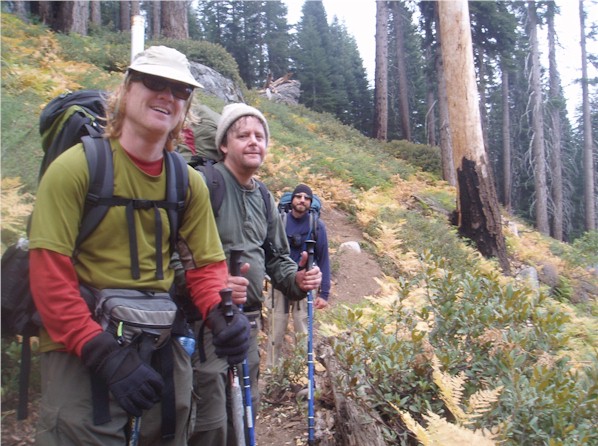|
|
|
|
|
Time: 9:30am -
6:00pm most days Narrative: Can you say Tehipite? I couldn’t, at least early in the planning of this trip I couldn’t. It’s pronounced Te- hip -i-tee, like Yosemite. That’s where I spent last week. A place called Tehipite Valley in SEKI, Kings Canyon National Park. Never heard of it? Neither has anyone else I’ve talked with except hardcore Sierra backpackers or folks familiar with the book- Angels in the Wilderness. From what I understand, Tehipite Valley is the home of the largest granite dome in the Sierra, Tehipite Dome. It is considered one of, if not the most remote region of the Sierra and gets so few visitors each year that the trail isn’t maintained. It’s home to rattlesnakes, black bears and the Middle Fork of the Kings River and often described as "Yosemite Valley without the roads." This trip was a year in the making or close to it. I and 6 other members of the Black Diamond Trout Society (BDTS), a loosely acquainted group of regulars to Fly Fisherman Magazines Southwest internet bulletin board, began a year long thread of correspondence in preparation for this trip. Early on we’d discussed the destination and the fact that, with the exception of carrying a satellite phone for emergencies, we’d plan to go as self-sufficient individuals- no sharing of gear, no planning of meals. We each knew that this trip should only be attempted by the fittest individuals and each person worked to get into shape in his own way. To some this meant lots of hiking, to others it meant lots of backpacking, to me it meant adding running to my normal fishing schedule of high country day hikes and backpacking trips. Unfortunately, this year’s illnesses conspired to scuttle my fitness so I became fanatical about reducing my pack weight. Last year I was able to get my pack weight down to 40lbs, this year I targeted 35lb but secretly hoped to hit sub 30lbs. Enter the book Lightweight Backpacking and Camping by the folks at backpackinglight.com. With my wallet $200 bucks lighter and no bear canister required, I was able to hit the trail with my pack at just under 31lbs.
We hit the trail early Saturday morning. There were 7 of us (as in the picture above- Bernard, Matt, Shaun, Kerry, Dan, Ted, Jim) and we split into 2 groups. The groups could be characterized as “fast” and “slow”. The fast group planned to cover the 15 plus miles into the valley in one day. (Most sources suggest the hike is actually 18 miles). This included a 3000 foot drop into the valley at the end of the hike, down very steep switchbacks. Knowing that the drop into the canyon had a reputation for being dangerous, that is- un-maintained, easy to lose, very steep, slick with pine needles, slick with oak leaves and guarded by rattlesnakes, I chose to finish the hike in the morning when I would be fresh and rested. You could say that the two groups divided along the lines of “sane” and, shall we say, those with “questionable judgment”. I’m kidding of course but the “fast” bunch was definitely hurting more than the “slow” bunch after the descent into the valley. They did get the benefit of an extra half day of fishing- so maybe it was worth it. The trail began by traversing the hillside of a lush rain forest. Douglas Firs dotted the land amid a dense carpet of green and yellow ferns. This led to higher ground and a forest of Lodgepole Pines which eventually lead to a forest of Redwoods and great Sequoias. We strode up and down for hours before finally settling into a small Sequoia grove next to Hay Meadow for the night. I set the pace for the slow group and we made it to as far as one mile from the rim of the canyon before deciding to make camp for the night. A camp fire was a luxury that I usually do not have during my backpacking trips but in this part of SEKI, fires were legal in pre-existing fire rings. Our camp site had such a ring and we gladly used it. The evening was relatively uneventful; we hung out by the fire swapping stories for a short time and then retired to our individual tents. It rained lightly and I knew that bears would not be a problem as the snoring of my two companions would keep all but the most daring bears away. My new REI Chrysalis tent worked well and I awoke warm and dry. Back on the trail we made it to the rim of Tehipite Valley in no time. The descent was tough. Steep and slick as promised with fallen trees and tree limbs across the trail. These would force us to limbo down sections of the trail in full packs with fly rod tubes sticking high overhead. The survey marker at the rim read 7117 feet and we knew the that the valley below was at 4100 feet or there about. 30 min into our descent I developed sewing machine leg. This is the uncontrollable twitching a leg goes into when overly stressed. I was experiencing it now and the altimeter in my watch told me that we had only covered 500 feet. A little creative descending was in order. I began switching my weight and moving my feet to constantly change how I was descending and which muscles were used. I heavily favored my left foot to prevent aggravating the tendonitis I developed this year in my right knee. The others employed creative descending of their own. Sometime we’d simply walk normally, other times we’d shuffle step, the best times where when we could simply slide step down the trail like a Nordic skier. The descent was agonizingly slow. The trail was steep. We seemed to descend at a good pace but we also seemed not to be getting any closer to the bottom. Finally when it seemed we were close to the bottom, we ran into the worst part of the trail. For some reason the trail was no longer a trail at all but simply switchbacks through a rock fall and to make things interesting, the rock fall had a few limbo limbs thrown in for good measure. The relief I felt after hiking through the rock fall was greater than the relief I’d feel at the bottom. Suddenly the trail became sane again and it was quite apparent that we were “down”. At that moment, a rattlesnake was thrown into the works to keep us on our toes. Shaun was waiting for us at the bottom to inform us that we had yet another half a mile to camp. Our first sight of the river was of Bernard and Ted fishing a hole that would be forever linked with Ted and the large fish he caught. I’d later do very well in the riffle just below. The flora at the bottom was quite diverse. We trudged from a high pine forest, through a virtual Louisiana swamp on our way to our Southwest desert like camp site. After taking a brief rest and setting up camp, I joined Bernard and Matt at Crown Creek. Crown Creek was a small boulder strewn stream in a canyon as narrow, at it's widest point, as an 8 lane highway. Matt had fished the creek the afternoon before and took us right to the best access point. Bernard was already rigged up and he made the first cast. Matt and I watched as a small fish immediately charged Bernard’s nymph. He missed the first strike but eventually hooked up and landed a small rainbow. I moved up to the next pool. I stood back from its edge so that I could watch the pool and rig up without spooking fish. Bernard, not realizing that I was getting ready to fish the pool, moved up and made a cast. “That’s my fish! I yelled as he landed another smallish rainbow. I moved up yet again and made several flip casts to the portion of the pool closest to me. I was trying to remove any sentinel fish before sending my fly into the main current. After releasing a small fish, I made a further cast to the near side of the main current. I was somewhat surprised when my Elk Hair Caddis wasn’t immediately molested. I made another cast, this time allowing the fly to float into the tail out. Slowly, a 7 inch fish, the largest so far, rose and grabbed the caddis before it floated out of range. Matt and Bernard moved up. Crown Creek flows through Crown Meadow above the valley and falls via Silver Spray Falls to where we were now standing. Bernard wanted to fish the pool at the base of the falls. Bernard hammered the falls pretty well and from my vantage point I could see the savage takes he was getting. I continued to fish the pools below Bernard, looking for the combination of fly, location and presentation which would capture fish as consistently as I thought it should. The average fish for the creek was probably 8 inches and on this first day I would pick up my largest Crown Creek fish, about 14 inches from an obscure pocket, no larger at the surface than a toilet bowl. Matt and Bernard left as I was still making my way up the creek. Bernard had hit the falls so efficiently that when I’d made my there, the fish weren’t very cooperative. No problem, I’d simply come back another day. As I made my way out of the small canyon, I became aware of the fact that I was not alone. I jumped on to a rock that I had crossed barely 20 minutes before and there at my feet was fresh bear scat. Matt and Bernard had passed the rock 10 minutes earlier and had not seen the scat. It rained pretty hard that night. The next morning I awoke early but stayed in my tent for a while as I tend to do. When it’s cold I’m a "get up when the sun hits the tent” sort but in this canyon, that would mean waiting until 10am. I did not leave camp until the sun hit the valley floor and on this day that would mean that I was at the confluence of Crown Creek and the Middle Fork at the perfect time. Before I did so, I was treated to the spectacle of a Forest Service helicopter landing right outside out camp. The helicopter circled as if it were looking for someone or something and in doing so gave us a unique perspective of just how large Tehipite Dome was and what it truly means to have descended one vertical mile into the canyon. Shortly before I left, National Park Ranger Tom walked over, apologized for all the ruckus and explain that he and another fellow were in Tehipite to document the Native American and old sheep herder sites. It seems that Tehipite means something like “the place to pass through” and was a freeway of sorts for Native American traders in the distant past. It seems unlikely but difficult as it may be to get into the valley, it is basically a straight shot up the valley to the mountains above Bishop, Ca. and to the Mono Basin area. At 4100 feet, Tehipite would be a great way to cross from east to west or west to east early and late in the season. Among the archaeological sites they were there to document were the large pictographs, called “paramecium” by our visitors.
That night both rangers shared our camp fire and swapped outdoor adventure stores. That would come later. Bernard and Ted had talked about the great fishing they had the night before at the confluence and I decided that I would start there and fish my way up Crown Creek to the falls. What I hadn’t realized is that the rain had risen the level of the creek. I would never get to fish the falls that day or at all for the rest of the trip. The fishing at the confluence was out of control. Near our campground, the Middle Fork divides around an island into 2 forks. Looking up stream, the right most fork travels through dense forest. The middle fork joins a small offshoot below our campground and meets with Crown Creek above. At the confluence with Crown Creek, the riffles and pocket water of the Middle Fork becomes a large pool. Not very deep, the entire run is probably 30 feet across. Chocolate milk stained water flowed out of Crown Creek on the left and quickly cleared, mixing with the Middle Fork flows.
The fishing was fast and furious. I fished without an indicator, making 20 to 35 foot casts and watching my fly leader and leader as it drifted back to me. I used a hand twist retrieve to gather in the slack and struck when my line appeared to jump upstream suddenly or seemed to drift more slowly than it should. An indicator would have been easier and probably picked up more fish but I chose to fish this way they entire trip. It was here I would see the largest fish of the trip. I made a cast to a small pocket just at the head of the pool and below the creek. It wasn’t a very deep spot and I don’t remember seeing a take but I struck none the less and was into a very large fish. The fish had taken the PT dropper and just as it was coming to hand it popped off, ensuring my continued skunk this season for fish in the 15 plus inches class. I fished the confluence until I sensed a slowing which basically meant until I went 5 casts without a take. In all, I easily landed 20 to 30 fish before moving into and up the creek. Fishing in the creek was initially slower than it had been the night before. The stream was stained and the fish didn’t appear to be able to see and charge the fly as they had done the night before. Initially, I was only picking up a fish in every second or third hole. I switched from the tan GRHE to a black Dark Lord and started picking up fish more consistently; it wasn’t until early afternoon when the water started to clear that I started picking up multiple fish per pool. I didn’t fish the waterfall pool. My hiking boots don’t grip well on wet surfaces. This made wading a challenge but also made making my way in higher water and over the wet boulders to the waterfall pool dangerous. The next morning I wasn’t quite sure where I was going to fish but I sort of felt it should be upstream. Most of the guys were fishing downstream but walking downstream simply to fish up always seems like a waste of valuable fishing time and I wasn’t ready to do it yet. I waded the river below the confluence with a plan to wade up the Middle Fork. It was obvious to me that the right bank wasn’t the bank to fish the confluence from and the fish were pretty much in agreement. I quickly moved up into the pocket water. The fishing here was tough. The center of the stream was deeper and faster than I had thought and I was forced to move up stream along the left bank. This was also difficult due to the slippery rocks and dense stream side vegetation. In comparison, actually catching fish wasn’t too difficult. If I could get past the logistical difficulties, I could catch fish. Here again I found another fly that the fish simply could not refuse. The day before, the fish shredded my GRHE; by the end of the day the fly had no tail, no collar and the gold rib was a curled up stump. It still caught fish. Today the killer combination was a Daves Hopper and that British fly I did well with on the Kern trib last year. I can’t remember the name but I think I’ll start referring to it as a Bright Butt Peacock and Black, for the two main ingredients in the fly and its bright floss hot spot. The fish would eagerly take the Dave’s Hopper but if seen first, would always take the Peacock and Black. I had 6 of these flies. I’d given one to Dan and by the end of the day I’d lost the rest. I love fishing pocket water but really haven’t done much of it lately. In the high country you fish small pocket streams but there’s nothing quite like making short accurate casts to pockets and riffles while standing in fast water. I love it. It took me most of the day to navigate the steep, brush laden portion of this stream but it eventually opened up. I was in a groove now. I’d learned to recognize the big fish water (11 to 13 inches) and began to fish it exclusively. Wednesday, the pull to fish upstream was strong but I fished downstream by default. I’d heard stories of the big fish downstream and wanted to find out what all the fuss was about. I hiked down the trail and found myself putting in just below where Dan and I had seen Bernard and Ted on our first day. The water here was swift and on average deeper than upstream. The fish were also on average about 3 inches longer. Upstream the average fish seemed to be 8 or 9 inches, down stream it was more like 11 or 12. I probably spent hours picking my way through this one riffle and picking up fish along the way.
I’d cast about 20 feet ahead of me and fan cast to an area about 15 feet wide. Starting right to left, that is... shallow to deep, I’d pick up fish as they were stationed across stream and then take a few steps and start again. This one riffle below the big fish pool held an incredible number of fish, including several Brown Trout. The Brown Trout on this trip had been quite elusive and it’s little wonder, most of the water was rainbow water. Still, the group had envisioned catching large Brownies on the spawn but it didn’t happen. The largest fish of the day was taken in an eddy below a fallen branch. I’d cast the fly under the branch as I had done a half dozen time earlier with no result. I took two steps forward and did it again. My fly landed perfectly motionless in the eddy. It probably had 3 seconds of float time but that was all that was needed. An acrobatic rainbow brought it’s body entirely out of the water when it struck. At first I’d thought I’d missed the fish. It was one of those strikes when you don’t really know if the fish took the fly on the way up or on the way down. Whenever it took the fly, the fish was on a mission and after it hit the water I set the hook. When I felt stiff resistance I figured the fish was foul hooked. I figured the fish landed on the fly and I hooked it in the side. I was pleasantly surprised when after a short fight I landed a nice rainbow just over 13 inches, hooked squarely in the jaw. The following morning we hiked out. I hoped we’d be able to do it in a single day. It was one thing to take two days to get in but after 3 days of great fishing, a day of hiking, followed by another day of hiking wasn’t very inviting. Most of the group was thinking the same thing and we figured that if we could get to the half way point by 4pm, we could push through to the cars, even in the dark. With this in mind, we hit the trail and I was home asleep by 12:30am.
Thanks to the team for allowing me to use their photos. Matt has posted a short video of the trip: http://www.blackdiamondtrout.com/Video/Tehipitetrek.wmv
Previous John Muir Wilderness Chronicle
Next John Muir Wilderness Chronicle
|

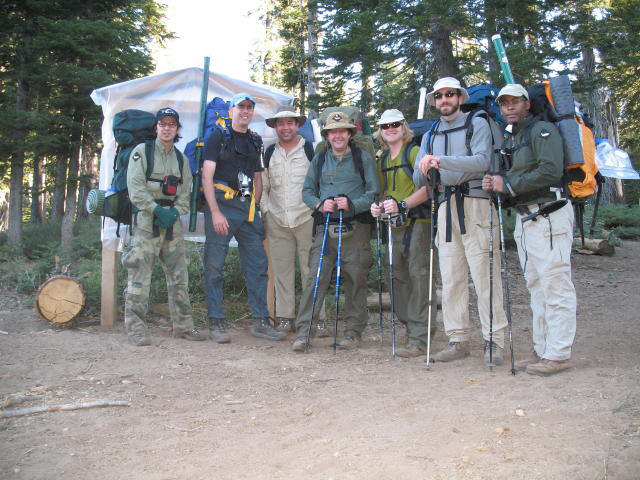
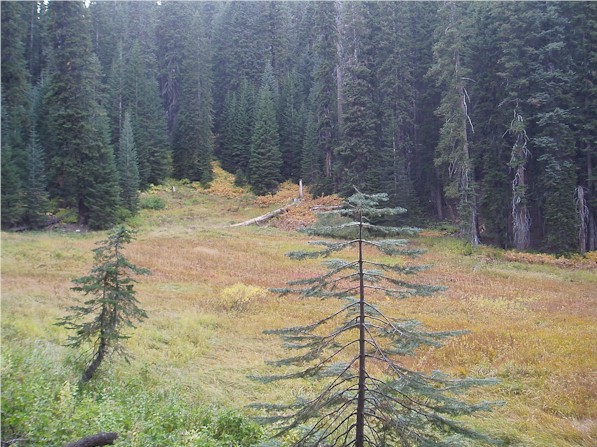
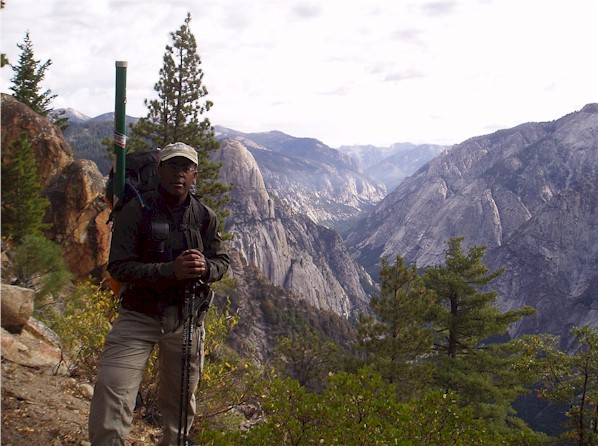
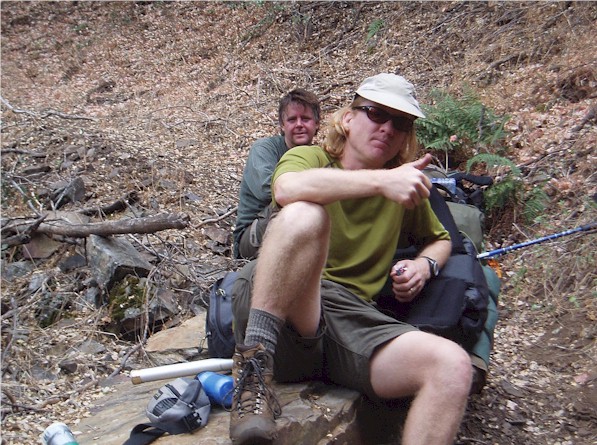
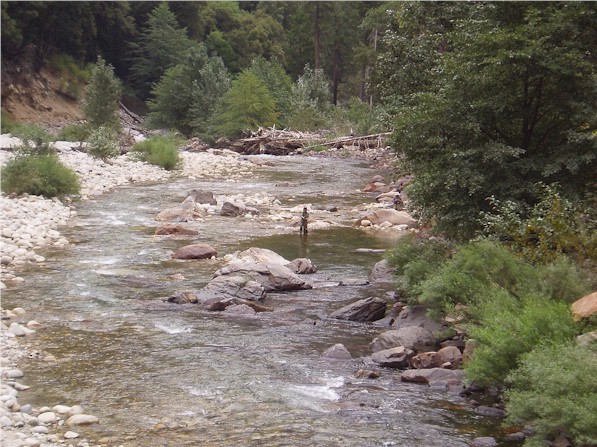

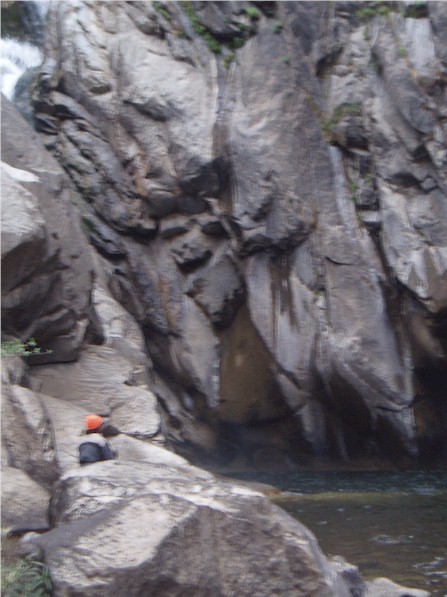

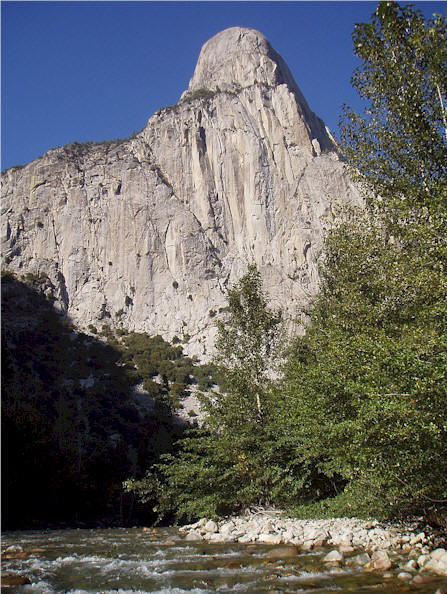 I
waded in below Crown Creek to about mid thigh. I watched as a medium sized
brown color mayfly fluttered down to the water and was engulfed in a splash.
I fished a similarly sized klinkhammer style fly but soon switched to a
beadhead gold ribbed hares ear with a PT dropper. I hadn’t fished either of
these flies in quite a few years but for this trip I made sure to fill my
fly box to the brim.
I
waded in below Crown Creek to about mid thigh. I watched as a medium sized
brown color mayfly fluttered down to the water and was engulfed in a splash.
I fished a similarly sized klinkhammer style fly but soon switched to a
beadhead gold ribbed hares ear with a PT dropper. I hadn’t fished either of
these flies in quite a few years but for this trip I made sure to fill my
fly box to the brim.